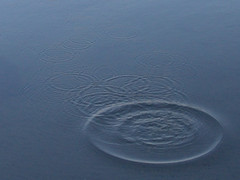 Here is how it works: Our mind is an empty wrapper. It can encapsulate any of our five senses and replay them. It is like an echo chamber. That’s why thoughts are in essence sense-less. They can contain (better: reflect) visual content or sounds which, as it happens, is in most cases our own sound – words. So why is it, that most of our mental objects are thoughts (vitakka) which reflect our own mentally recorded voice?
Here is how it works: Our mind is an empty wrapper. It can encapsulate any of our five senses and replay them. It is like an echo chamber. That’s why thoughts are in essence sense-less. They can contain (better: reflect) visual content or sounds which, as it happens, is in most cases our own sound – words. So why is it, that most of our mental objects are thoughts (vitakka) which reflect our own mentally recorded voice?
As we humans are mainly driven by sights and sounds these two therefore reflect most of our thoughts – visual memories or discursive thoughts which are merely an expression of the minds basic ability to pop up whatever was put into it and endlessly recombine it. But whereas our visual sense always perceives something which is outside of us (“alien”, “the other”, “bahiddha”) it is the hearing which perceives others but for a much larger part of the day it follows our own voice our own sounds. This sound coming from “within” (in our perception) makes it range so much closer to what we perceive as “ourselves”. Sounds then, especially their mental representation of our own sound, our voice, is the perfect narrative to comment on the impulses which we perceive as “our own ideas”. That is why most of us have lots of mental chatter go on – propping up the self-perception.
A funny side effect of all of this is of course the fact that this mental reproduction of sense objects is a completely recursive procedure – A picture can be seen by the eye, then mentally encapsulated as a mind object then that mind object itself can again be encapsulated by another mind object which triggers another sound (voiced) thought etc etc. You can picture this process as a chain of events, but you can also imagine it simply as a ida-paccayata “this is based on that” (so rather a chain, visualize a pyramid where one object rests on the shoulders of the other).
 In any event you can now understand why the Buddha never called the objects of the mind “thought” (or vitakka) but rather “dhammas” (things). Because, looking at their essence, “vitakka” has more to do with language as being a “voiced or sounded thought object” and is just one of the many “objects” (dhammas) the mind can echo (including but not limited to form which is visual, or taste or a memory of a smell).
In any event you can now understand why the Buddha never called the objects of the mind “thought” (or vitakka) but rather “dhammas” (things). Because, looking at their essence, “vitakka” has more to do with language as being a “voiced or sounded thought object” and is just one of the many “objects” (dhammas) the mind can echo (including but not limited to form which is visual, or taste or a memory of a smell).
‘‘Assāsapassāsā kho, āvuso visākha, kāyikā ete dhammā kāyappaṭibaddhā, tasmā assāsapassāsā kāyasaṅkhāro. Pubbe kho, āvuso visākha, vitakketvā vicāretvā pacchā vācaṃ bhindati, tasmā vitakkavicārā vacīsaṅkhāro. Saññā ca vedanā ca cetasikā ete dhammā cittappaṭibaddhā, tasmā saññā ca vedanā ca cittasaṅkhāro’’ti. Cūlavedalla Sutta, MN.
Inbreath and outbreath, brother Visākha, are bodily things, depend on the body, therefore in- and outbreathing is a body-activity. Because first, brother Visākha, one thinks and dwells and then bursts into speech, therefore thought-and-mental-dwelling are activities of speech (voice, vācā). Perception and feeling are mental things, depend on the mind, therefore perception and feeling are activities of the mind.” (Here explained in a discourse given by Arahant nun Dhammadinna)
All the while these three (sense-base + object + consciousness thereof) together form one experiential moment after the other they each trigger a feeling (or sensation) like a shower or cannonade of little pebbles thrown into a pool. All these feelings triggered by each sense impression (including the perception of a mind object) cause circles of waves. Most of these feelings are extremely transitory, but the waves they help to build eventually build up and come back to haunt us:
Whatever you think about over and over again thereto the mind is bent (yannadeva bhikkhu bahulam anuvitakketi anuvicareti, tatha tatha nati hoti cetaso).
 A swell of negative feelings creates a steep inclination. The same is true for a positive set of feelings, of course. Please don’t mistake consciousness with what we call mind in this case. See, the fact is that you are conscious or experience or recognize each individual moment as such – at least in theory, but of course for most of us its most of the time a blur regarding the speed of events or rather the underdeveloped state of our concentration.
A swell of negative feelings creates a steep inclination. The same is true for a positive set of feelings, of course. Please don’t mistake consciousness with what we call mind in this case. See, the fact is that you are conscious or experience or recognize each individual moment as such – at least in theory, but of course for most of us its most of the time a blur regarding the speed of events or rather the underdeveloped state of our concentration.
Now the consciousness in each sense impression also applies to the mind. There can be awareness or experience of the moment where the mind-(sense)-base meets/aligns with an object (dhamma) – a representation. So even here, not just in the moment your eye meets the smile of a pretty girl, but also when a mental voice / image is recognized in consciousness – also in such a case a feeling arises.
When I see a ball, I am conscious of the ball. In the next moment I hear a child’s voice, so I am conscious of a sound. Then, in the next moment I might experience a mental reflection (as an image or taste but most likely a sound – my own voice, thinking: ‘be careful’). So when my mind experiences that mental object, I am conscious of a mental object. This is why the Buddha carefully distinguishes between eye (sight) – visual object – visual consciousness….hearing facility, sound object, hearing consciousness….and mind object, mind and mind-consciousness.
Highly recommended reading:
Samyutta-Nikaya, Vedanasamyutta, Sutta No. 6 “The dart” (Sallasutta)

So ekaṃ vedanaṃ vedayati – kāyikaṃ, na cetasikaṃ.
And so he feels only one feeling – a bodily not mental.

Daniel
You said: “But whereas our visual sense always perceives something which is outside of us (“alien”, “the other”, “bahiddha”) it is the hearing which perceives others but for a much larger part of the day it follows our own voice our own sounds.”
I have have found in my practice that the mental images we have of our bodies make up a crucial part of our identity construct. The mind uses various mental images of our body as glue placed (in extremely rapid flashes) between our other forms of mental and sensory impression to help create a continuous sense of “I” as perceiver and thinker. Without these, its seems to me, even the inner narrative could not be taken as me or mine. The body, its tactile processes, feelings and it’s mental representations are the most basic materials for “I-making.” Hence the extraordinary value of those mindfulness of the body exercises that penetrate this delusion: the use of tactile processes as primary objects in the practice of bare insight, patikula bhavana (32 parts of the body), meditation on the elements and the corpse meditations that are so effective in countering this delusion. I have found 32 parts of the body particularly effective and I am amazed at how this practice is so thoroughly neglected in Western Theravada.